Visual Storytelling of Landscape Change on Rathlin Island, UK
Abstract
1. Introduction
2. Literature Review
2.1. The Role of Storytelling in Cultural Heritage and Environmental Education
2.2. Visual Storytelling in Island Studies
2.3. Technological Tools for Visual Storytelling
3. Materials and Methods
3.1. Case Study Area
3.2. Methods
- Method one: Historic Environment Map Viewer
- Method two: Environment Digimap
- Method three: Google Maps and Google Street View
- Method four: ArcGIS Field Maps
4. Results
4.1. Results from the Historic Environment Map Viewer
- Topographical Changes
- Infrastructure Development and Land Use [60]
4.2. Results from Environment Digimap
4.3. Results from Google Maps and Google Street View
4.4. Results from ArcGIS Field Maps
5. Discussion
6. Conclusions
Future Directions
Author Contributions
Funding
Data Availability Statement
Conflicts of Interest
References
- Pathirana, A. Small islands: Living Laboratories revealing global climate and sustainable development challenges. Front. Clim. 2025, 6, 1445378. [Google Scholar] [CrossRef]
- Giardino, A.; Nederhoff, K.; Vousdoukas, M. Coastal hazard risk assessment for small islands: Assessing the impact of climate change and disaster reduction measures on Ebeye (Marshall Islands). Reg. Environ. Change 2018, 18, 2237–2248. [Google Scholar] [CrossRef]
- Nurse, L.A.; McLean, R.F.; Agard, J.; Briguglio, L.P.; Duvat-Magnan, V.; Pelesikoti, N.; Tompkins, E.; Webb, A. Small Islands. In Climate Change 2014: Impacts, Adaptation, and Vulnerability. Part B: Regional Aspects. Contribution of Working Group II to the Fifth Assessment Report of the Intergovernmental Panel on Climate Change; Barros, V.R., Field, C.B., Dokken, D.J., Mastrandrea, M.D., Mach, K.J., Bilir, T.E., Chatterjee, M., Ebi, K.L., Estrada, Y.O., Genova, R.C., et al., Eds.; Cambridge University Press: Cambridge, UK, 2014; pp. 1613–1654. [Google Scholar]
- Baldacchino, G. Introducing a world of islands [Editorial]. In A World of Islands: An Island Studies Reader; Baldacchino, G., Ed.; Island Studies Press: Charlottetown, PEI, Canada, 2007; pp. 1–29. [Google Scholar]
- Vousdoukas, M.I.; Athanasiou, P.; Giardino, A.; Mentaschi, L.; Stocchino, A.; Kopp, R.E.; Menéndez, P.; Beck, M.W.; Ranasinghe, R.; Feyen, L. Small Island Developing States under threat by rising seas even in a 1.5 °C warming world. Nat. Sustain. 2023, 6, 1089–1099. [Google Scholar] [CrossRef]
- Mycoo, M.; Robinson, S.-A.; Wairiu, M.; Duvat, V. Climate change adaptation in small islands: A systematic literature review. Reg. Environ. Change 2022, 22, 55. [Google Scholar] [CrossRef]
- Robinson, S.-A. Climate change adaptation in SIDS: A systematic review of the literature pre and post the IPCC Fifth Assessment Report. Wiley Interdiscip. Rev. Clim. Change 2020, 11, e653. [Google Scholar] [CrossRef]
- Vousdoukas, M.I.; Ranasinghe, R.; Mentaschi, L.; Plomaritis, T.A.; Athanasiou, P.; Luijendijk, A.; Feyen, L. Sandy coastlines under threat of erosion. Nat. Clim. Change 2020, 10, 260–263. [Google Scholar] [CrossRef]
- Niles, K.; Lloyd, B. Small Island Developing States (SIDS) & Energy Aid: Impacts on the Energy Sector in the Caribbean and Pacific. Energy Sustain. Dev. 2013, 17, 521–530. [Google Scholar] [CrossRef]
- Briguglio, L. Economic Challenges Faced by Small Island Economies: An Overview. World Dev. 1995, 23, 1615–1629. [Google Scholar] [CrossRef]
- Bárcena, C.; Darnaude, A.M.; Planas, A. The Importance of Islands for the Protection of Biological and Linguistic Diversity. Glob. Ecol. Conserv. 2022, 34, e02054. [Google Scholar] [CrossRef]
- Cutter, S.L.; Emrich, C.T.; Webb, J.J.; Morath, D.P. Interdisciplinary Theory, Methods, and Approaches for Hazards and Disaster Research: An Introduction to the Special Issue. Risk Anal. 2021, 41, 1059–1067. [Google Scholar] [CrossRef]
- Prosser, J. Visual Data in Applied Qualitative Research: Lessons from Experience. In The SAGE Handbook of Qualitative Research; Miles, M., Huberman, A.M., Eds.; Sage Publications: Thousand Oaks, CA, USA, 2005; pp. 143–155. [Google Scholar]
- Zort, Ç.; Karabacak, E.; Öznur, Ş.; Dağlı, G. Sharing of Cultural Values and Heritage through Storytelling in the Digital Age. Front. Psychol. 2023, 14, 1104121. [Google Scholar] [CrossRef] [PubMed]
- Carvalho, D.B.; Clua, E.G.; Pozzer, C.T.; Passos, E.B.; Paes, A. Simulated Perceptions for Emergent Storytelling. Comput. Intell. 2017, 33, 606–627. [Google Scholar] [CrossRef]
- Katifori, A.; Karvounis, M.; Kourtis, V.; Perry, S.; Roussou, M.; Ioannidis, Y. Applying Interactive Storytelling in Cultural Heritage: Opportunities, Challenges and Lessons Learned. Lect. Notes Comput. 2018, 11318, 603–612. [Google Scholar] [CrossRef]
- Sacks, R.; Brilakis, I.; Pikas, E.; Xie, H.; Girolami, M. A Research Agenda for Augmented and Virtual Reality in Architecture, Engineering and Construction. Adv. Eng. Inform. 2020, 45, 101122. [Google Scholar] [CrossRef]
- Zhang, R.; Peng, F.; Gwilt, I. Exploring the Role of Immersive Technology in Digitally Representing Contemporary Crafts within Hybrid Museum Exhibitions: A Scoping Review. Digit. Creat. 2024, 35, 355–377. [Google Scholar] [CrossRef]
- Throgmorton, J.A. Planning as Persuasive Storytelling in a Global-Scale Web of Relationships. Plan. Theory 2003, 2, 125–151. [Google Scholar] [CrossRef]
- Eckstein, B.; Throgmorton, J.A. (Eds.) Story and Sustainability: Planning, Practice, and Possibility for American Cities; The MIT Press: Cambridge, MA, USA, 2003. [Google Scholar] [CrossRef]
- Fonseca, L.M.; Domingues, J.P. How to succeed in the digital age? Monitor the organizational context, identify risks and opportunities, and manage change effectively. Manag. Mark. 2017, 12, 443–455. [Google Scholar] [CrossRef]
- Shanahan, E.A.; McBeth, M.K.; Hathaway, P.L. Narrative Policy Framework: The Influence of Media Policy Narratives on Public Opinion. Politics Policy 2011, 39, 373–400. [Google Scholar] [CrossRef]
- Joosse, S.; Westin, M.; Möckel, F.; Keasey, H.; Lorenzen, S. Storytelling to Save the Planet: Who Gets to Say What Is Sustainable, Who Tells the Stories, and Who Should Listen and Change? J. Environ. Plan. Manag. 2023, 67. [Google Scholar] [CrossRef]
- Baldacchino, G. The Lure of the Island: A Spatial Analysis of Power Relations. J. Mar. Isl. Cult. 2012, 1, 55–62. [Google Scholar] [CrossRef]
- Hamad, A.; Jia, B. How Virtual Reality Technology Has Changed Our Lives: An Overview of the Current and Potential Applications and Limitations. Int. J. Environ. Res. Public Health 2022, 19, 11278. [Google Scholar] [CrossRef]
- Bakhtiari, V.; Piadeh, F.; Behzadian, K.; Kapelan, Z. A Critical Review for the Application of Cutting-Edge Digital Visualisation Technologies for Effective Urban Flood Risk Management. Sustain. Cities Soc. 2023, 99, 104958. [Google Scholar] [CrossRef]
- Gershon, N.; Page, W. What storytelling can do for information visualization. Commun. ACM 2001, 44, 31–37. [Google Scholar] [CrossRef]
- Weissenfeld, K.; Abramova, O.; Krasnova, H. Understanding Storytelling in the Context of Information Systems. In Proceedings of the 23rd Americas Conference on Information Systems (AMCIS 2017), Boston, MA, USA, 10–12 August 2017; Available online: https://aisel.aisnet.org/amcis2017/eBusiness/Presentations/20 (accessed on 21 May 2025).
- Kosara, R.; Mackinlay, J. Storytelling: The Next Step for Visualization. Computer 2013, 46, 44–50. [Google Scholar] [CrossRef]
- Roth, R.E. Cartographic Design as Visual Storytelling: Synthesis and Review of Map-Based Narratives, Genres, and Tropes. Cartogr. J. 2020, 58, 83–114. [Google Scholar] [CrossRef]
- Gray, J.; Chambers, L.; Bounegru, L. The Data Journalism Handbook: How Journalists can Use Data to Improve the News; O’Reilly: Sebastopol, CA, USA, 2012. [Google Scholar]
- Thöny, M.; Schnürer, R.; Sieber, R.; Hurni, L.; Pajarola, R. Storytelling in Interactive 3D Geographic Visualization Systems. ISPRS Int. J. Geo-Inf. 2018, 7, 123. [Google Scholar] [CrossRef]
- Department for Communities. Historic Environment. Available online: https://www.communities-ni.gov.uk/topics/historic-environment (accessed on 5 March 2025).
- Environment Digimap. Available online: https://digimap.edina.ac.uk/environment (accessed on 1 April 2025).
- Google Maps. Available online: https://www.google.com/maps (accessed on 21 May 2025).
- Google Street View. Available online: https://www.google.com/streetview/ (accessed on 3 April 2025).
- Arc GIS Field Maps. Available online: https://www.esri.com/en-us/arcgis/products/arcgis-field-maps/overview (accessed on 4 April 2025).
- Cisneros, L.; Campbell, T.; Freidenfelds, N.; Lindemann, A.; Elliot-Famularo, H.; Chadwick, C.; Dickson, D.; Park, B.-Y. Eco-Digital Storytelling: Engaging Historically Excluded Populations in Environmental Action through Mentoring, Geospatial Technology, and Digital Media Storytelling. Front. Educ. 2023, 7, 1083064. [Google Scholar] [CrossRef]
- Quinn, R.; Forsythe, W.; Breen, C.; McCarron, S.; Plets, R.; Westley, K. Comparison of the Maritime Sites and Monuments Record with Side-Scan Sonar and Diver Surveys: A Case Study from Rathlin Island, Ireland. Geoarchaeology 2002, 17, 441–451. [Google Scholar] [CrossRef]
- Goodchild, M.F. Citizens as Sensors: The World of Volunteered Geography. GeoJournal 2007, 69, 211–221. [Google Scholar] [CrossRef]
- Peterson, G.N. GIS Cartography: A Guide to Effective Map Design; CRC Press: Boca Raton, FL, USA, 2015. [Google Scholar]
- Stewart, S.A. Report on the Botany of the Island of Rathlin, County of Antrim. Proc. R. Ir. Acad. Sci. 1888, 4, 82–104. Available online: https://www.jstor.org/stable/20635914 (accessed on 6 April 2025).
- Martin, P. Rathlin Island: An Archaeological Survey of a Maritime Landscape. Int. J. Naut. Archaeol. 2014, 43, 226–228. [Google Scholar] [CrossRef]
- Documenting Ireland. Rathlin Island. Documenting Ireland. Available online: https://documentingireland.com/northern-ireland/rathlin-island/ (accessed on 7 April 2025).
- Forsythe, W.; McConkey, R. At the Crossroads: The Historical Archaeology of Rathlin Island. In Scottish Odysseys: The Archaeology of Islands; Noble, G., Poller, T., Raven, J., Verrill, L., Eds.; The History Press: Stroud, UK, 2008; pp. 132–149. [Google Scholar]
- Garrow, D.; Sturt, F. The Role of Stone in Island Societies in Neolithic Atlantic Europe: Creating Places and Cultural Landscapes. In Submerged Prehistory; Bailey, G., Harff, J., Sakellariou, D., Eds.; Springer: Cham, Switzerland, 2017; pp. 145–157. [Google Scholar] [CrossRef]
- Department for Communities. Former Coastguard Lookout Post, Rathlin Island (HB 06/500017). Northern Ireland Buildings Database. Available online: https://apps.communities-ni.gov.uk/Buildings/buildview.aspx?id=18411&js=false (accessed on 5 June 2025).
- Goodwin, C.; Edwards, H.; Breen, J.; Picton, B. Rathlin Island—A Survey Report from the Nationally Important Marine Features Project 2009–2011; Northern Ireland Environment Agency Research and Development Series No. 11/03; Northern Ireland Environment Agency: Belfast, UK, 2011. [Google Scholar] [CrossRef]
- Ortiz, A.M.D.; Jamero, M.L.; Crespin, S.J.; Agostini, V.N.; Schwerdtner Máñez, K.; Morrison, T.H.; Sanz, V.; Barnett, J. The Land and Sea Routes to 2030: A Call for Greater Attention on All Small Islands in Global Environmental Policy. NPJ Biodivers. 2023, 2, 18. [Google Scholar] [CrossRef]
- Veron, S.; Mouchet, M.; Govaerts, R.; Haevermans, T.; Pellens, R. Vulnerability to Climate Change of Islands Worldwide and Its Impact on the Tree of Life. Sci. Rep. 2019, 9, 14471. [Google Scholar] [CrossRef] [PubMed]
- RSPB. LIFE Raft on Rathlin: A Monumental Step for Seabird Conservation. RSPB News, 22 October 2024. Available online: https://www.rspb.org.uk/whats-happening/news/life-raft-on-rathlin (accessed on 6 April 2025).
- Department for Regional Development. Regional Development Strategy 2035: Building a Better Future; Department for Regional Development: Belfast, UK, 2012. Available online: https://www.infrastructure-ni.gov.uk/publications/regional-development-strategy-2035 (accessed on 21 May 2025).
- Department for Regional Development. Rathlin Island Harbour Development: Environmental Statement; Department for Regional Development: Belfast, UK, 2012. Available online: https://www.infrastructure-ni.gov.uk/sites/default/files/publications/drd/rathlin-island-harbour-environmental-statement.pdf (accessed on 21 May 2025).
- Department of Housing, Heritage and Local Government. Historic Environment Viewer. Available online: https://heritagedata.maps.arcgis.com/apps/webappviewer/index.html?id=0c9eb9575b544081b0d296436d8f60f8 (accessed on 8 April 2025).
- Sutton, E.; Medyckyj-Scott, D.; Urwin, T. The EDINA Digimap® Service—10 Years On…. Cartogr. J. 2007, 44, 268–275. [Google Scholar] [CrossRef]
- Google Maps. Available online: https://www.google.co.uk/maps/ (accessed on 18 May 2025).
- Li, Y.; Peng, L.; Wu, C.; Zhang, J. Street View Imagery (SVI) in the Built Environment: A Theoretical and Systematic Review. Buildings 2022, 12, 1189. [Google Scholar] [CrossRef]
- Rundle, A.G.; Bader, M.D.M.; Richards, C.A.; Neckerman, K.M.; Teitler, J.O. Using Google Street View to Audit Neighborhood Environments. Am. J. Prev. Med. 2011, 40, 94–100. [Google Scholar] [CrossRef]
- Wilson, P.; Byrum, S.; Wilson, P. Geospatial Technologies. In Smart Grids, 2nd ed.; CRC Press: Boca Raton, FL, USA, 2017; p. 26. [Google Scholar] [CrossRef]
- Rossiter, K.M. Using ArcGIS Field Maps in the Classroom. Geogr. Teach. 2022, 19, 154–161. [Google Scholar] [CrossRef]
- Glens of Antrim Historical Society. The Ordnance Survey Memoir for the Parish of Rathlin; Glens of Antrim Historical Society: Ballycastle, UK, 2015; Available online: https://antrimhistory.net/the-ordnance-survey-memoir-for-the-parish-of-rathlin/ (accessed on 21 May 2025).
- Tourism Northern Ireland. New Capital Investment Funding Scheme Announced for Visitor Attractions and Experiences as Part of the Shared Island Tourism Brand Collaboration Project; Tourism Northern Ireland: Belfast, UK, 2024; Available online: https://www.tourismni.com/news/new-capital-investment-funding-scheme-announced-for-visitor-attractions-and-experiences-as-part-of-the-shared-island-tourism-brand-collaboration-project/ (accessed on 21 May 2025).
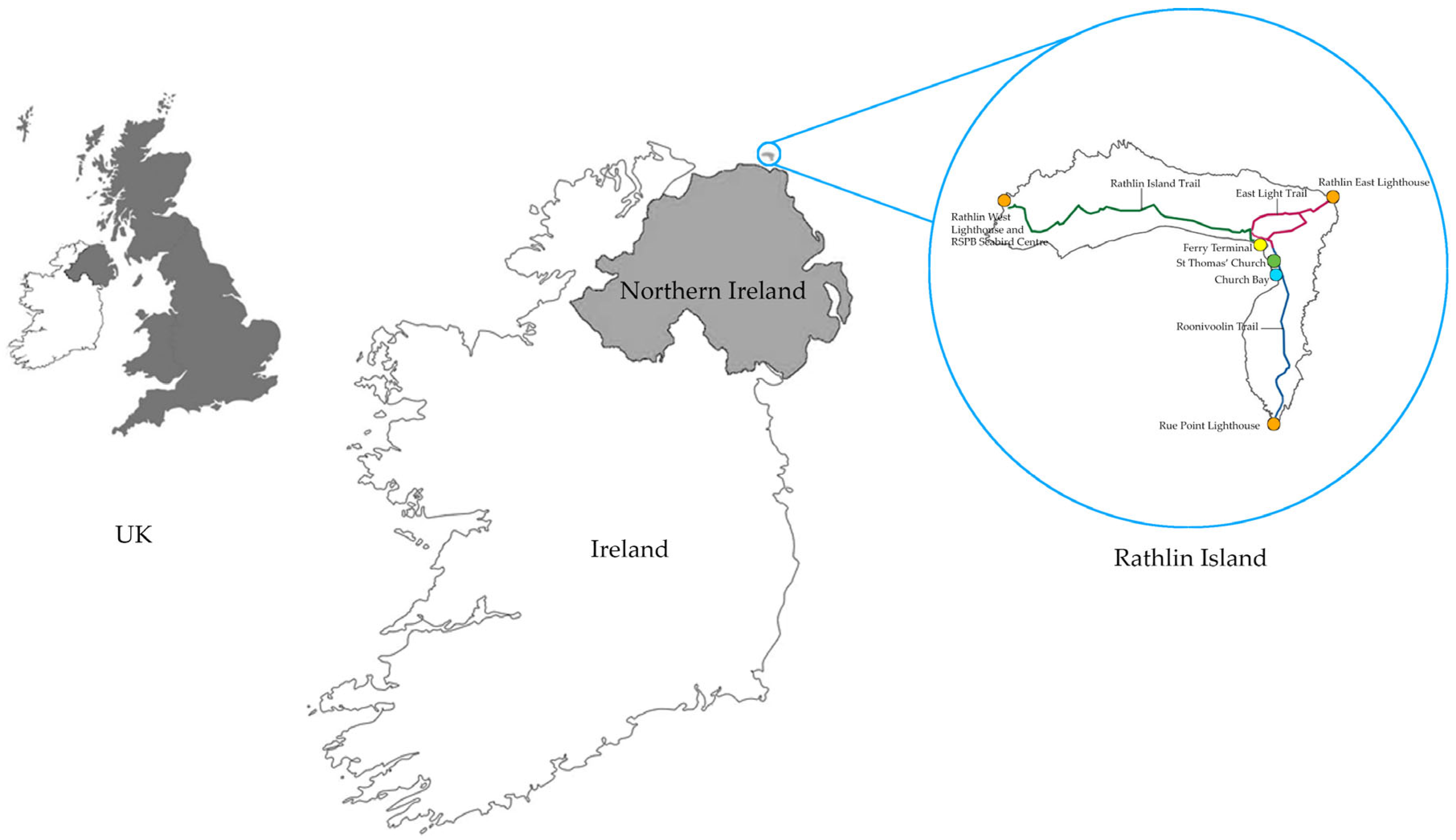
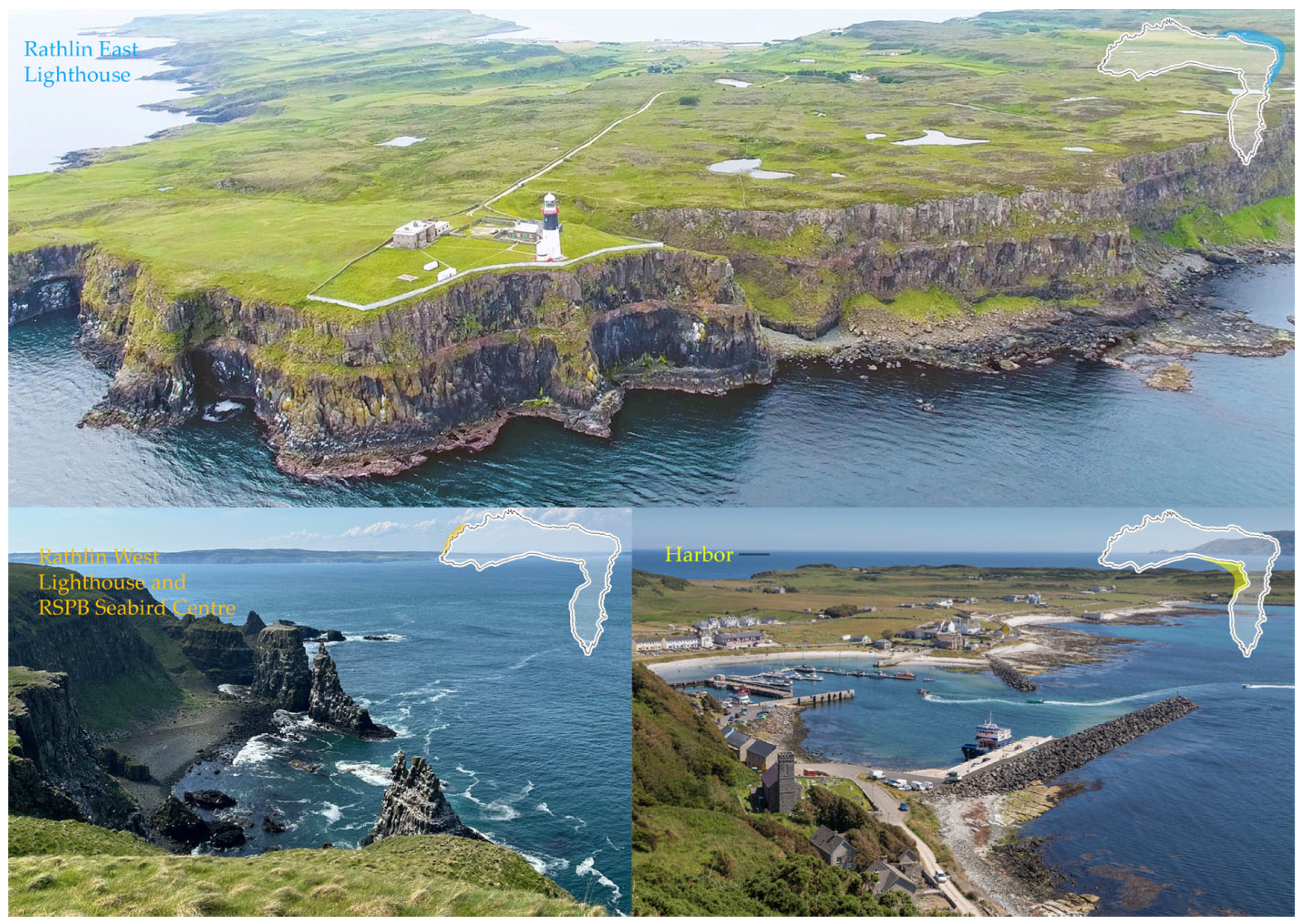
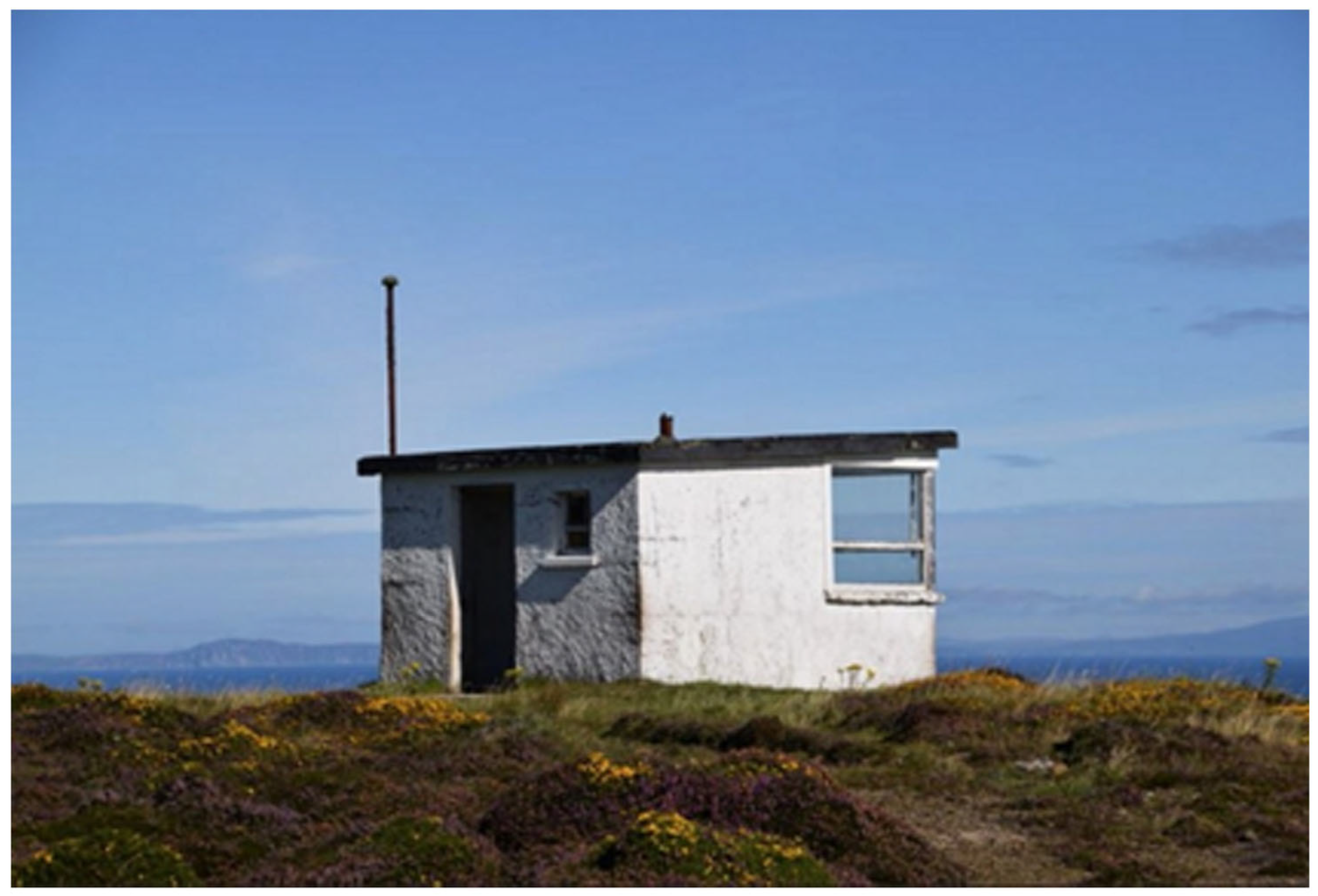
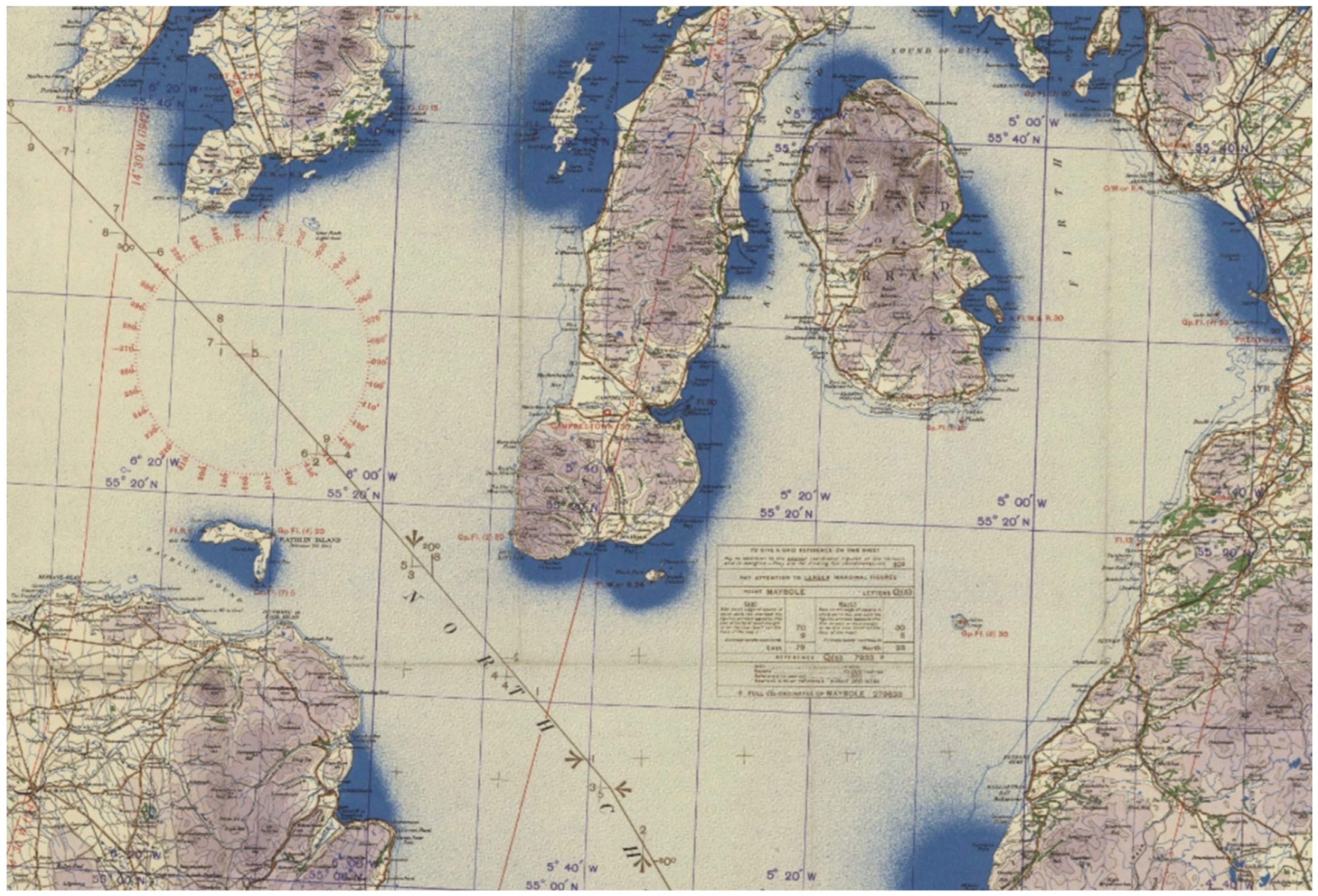
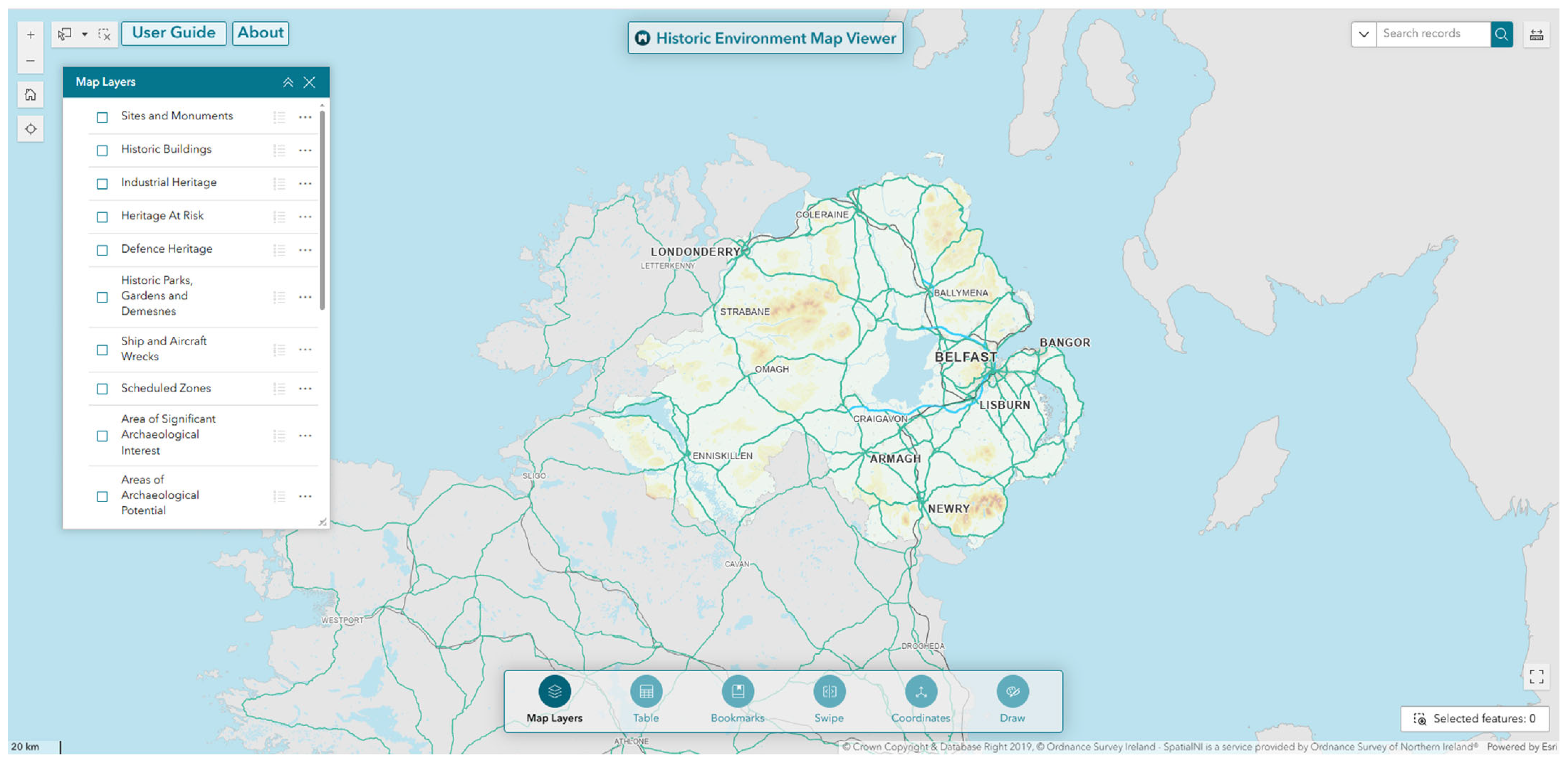
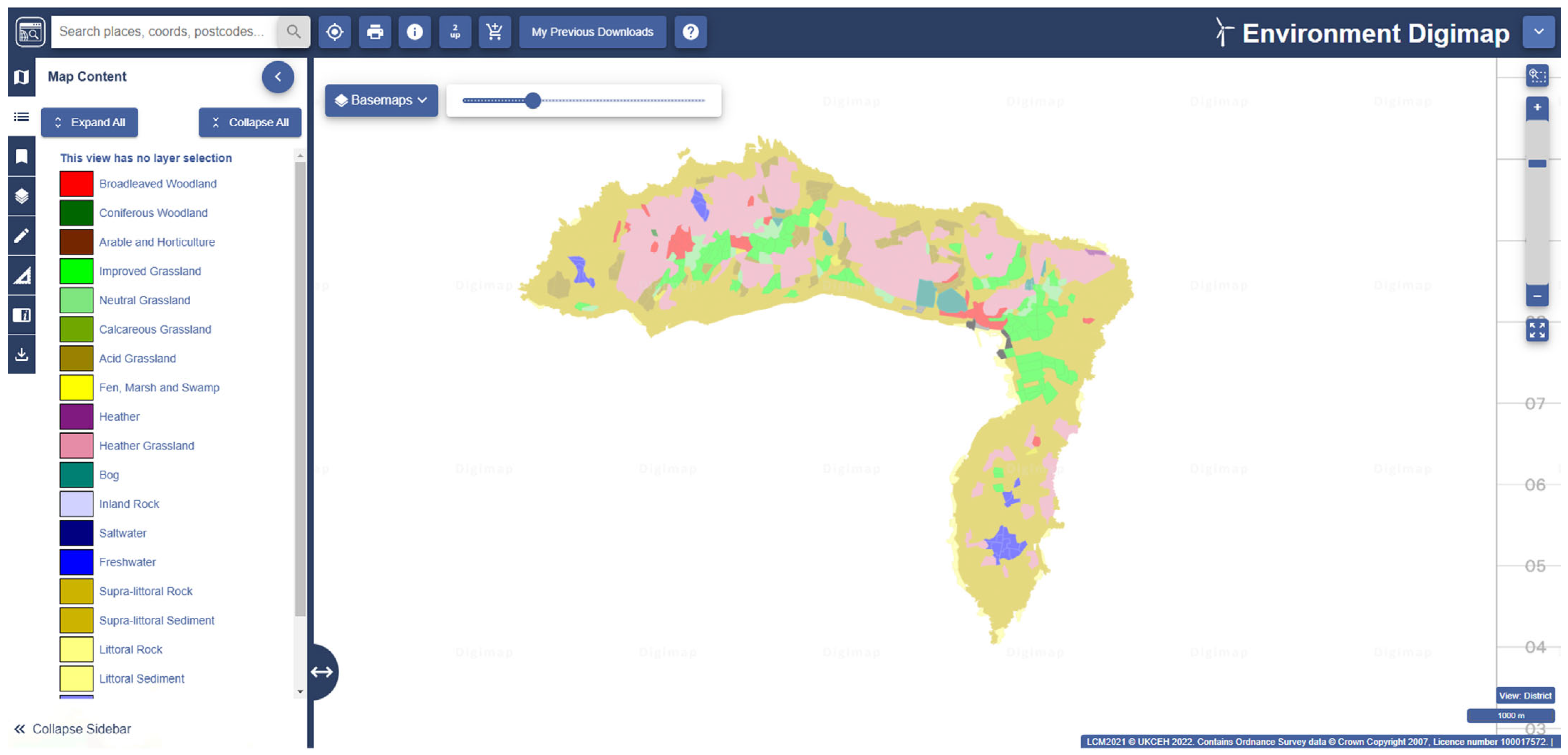
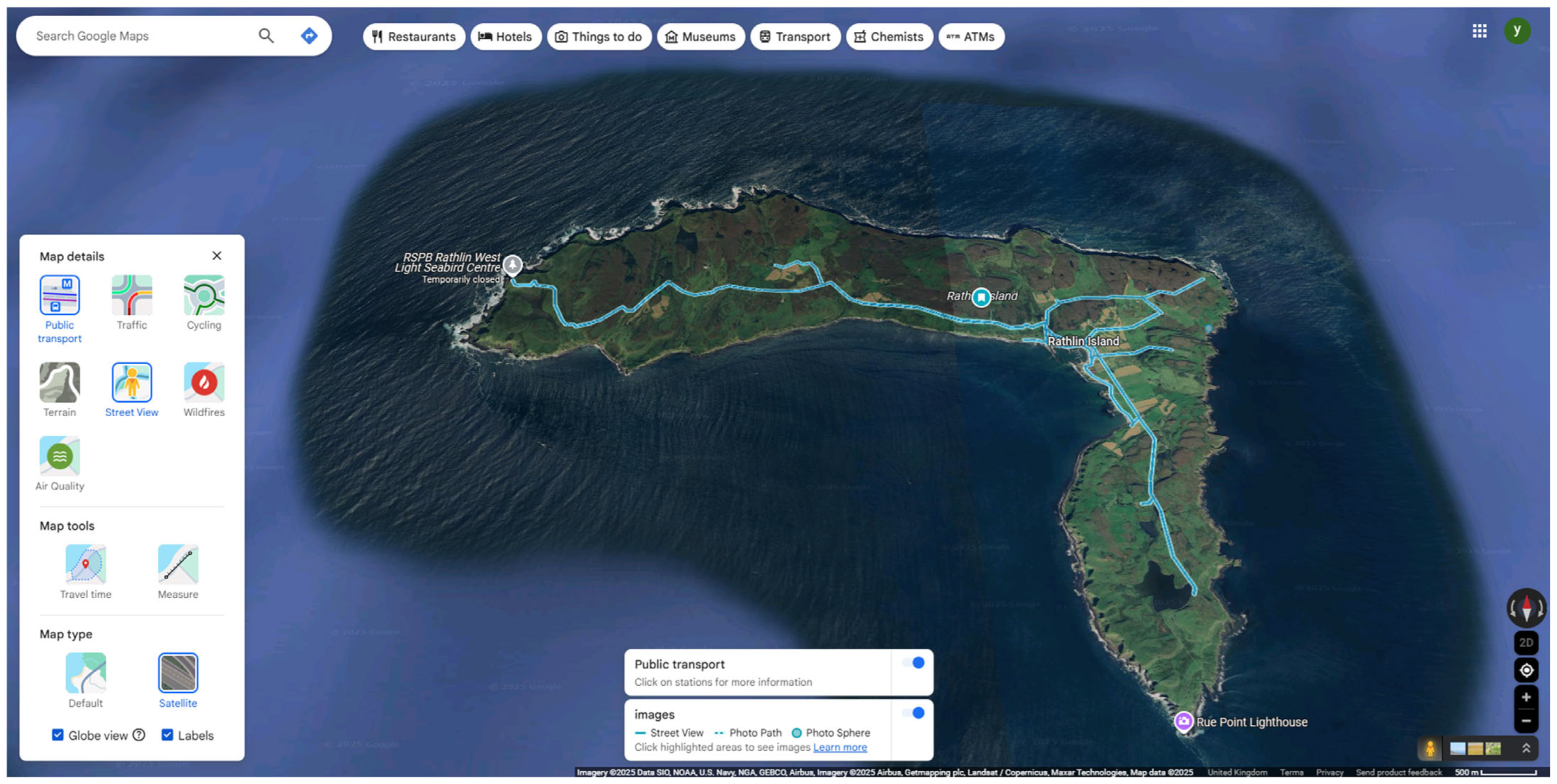




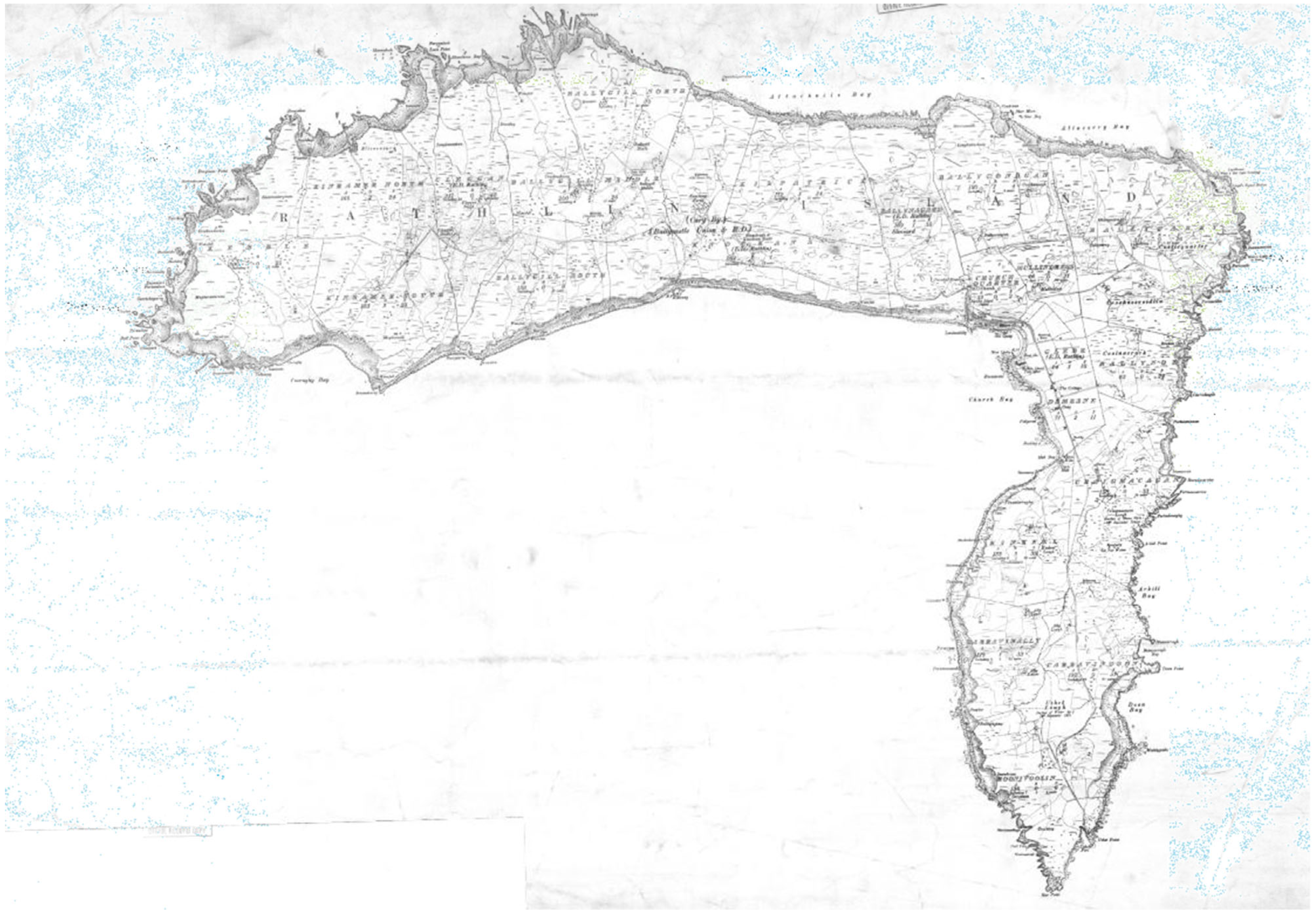
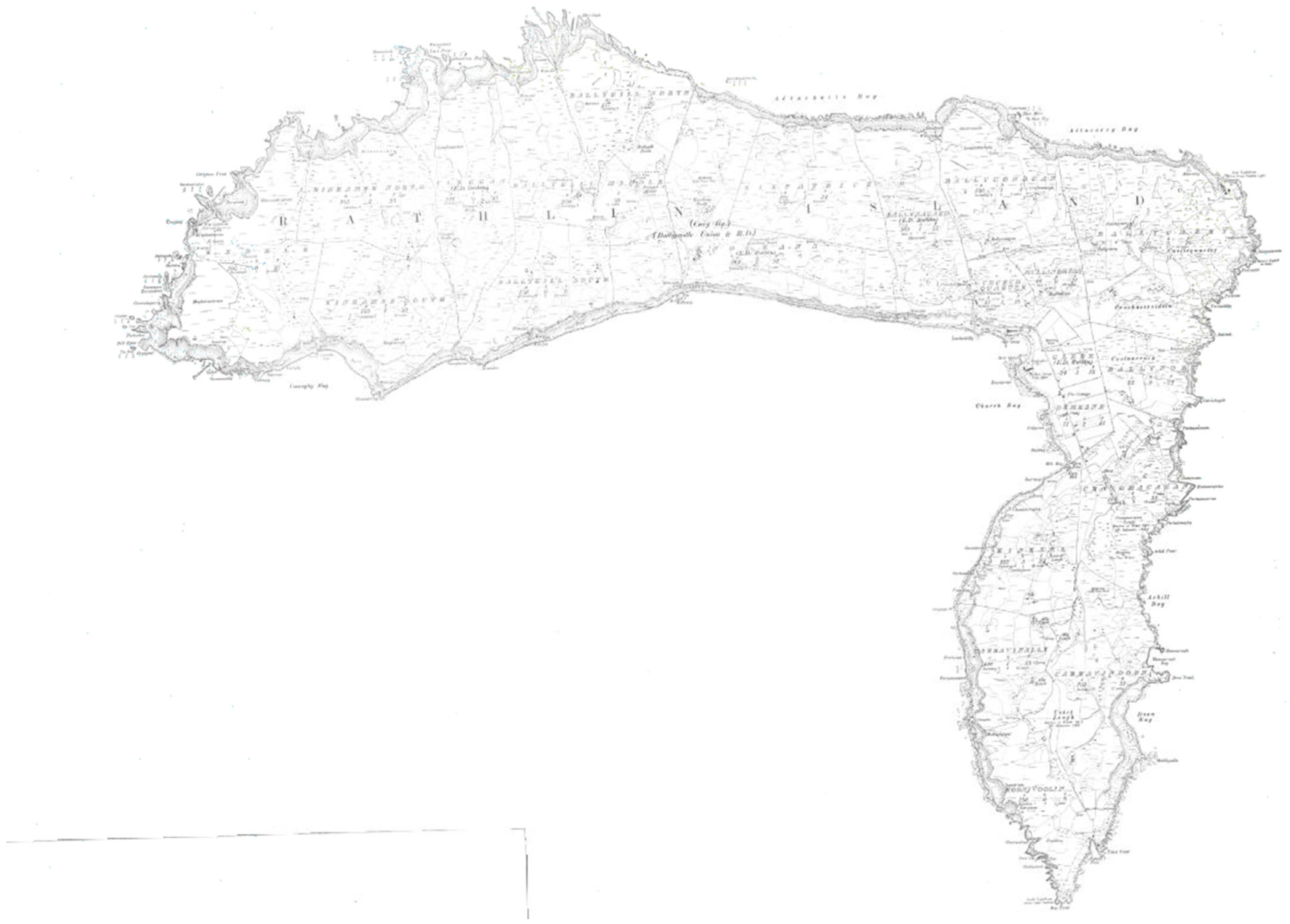
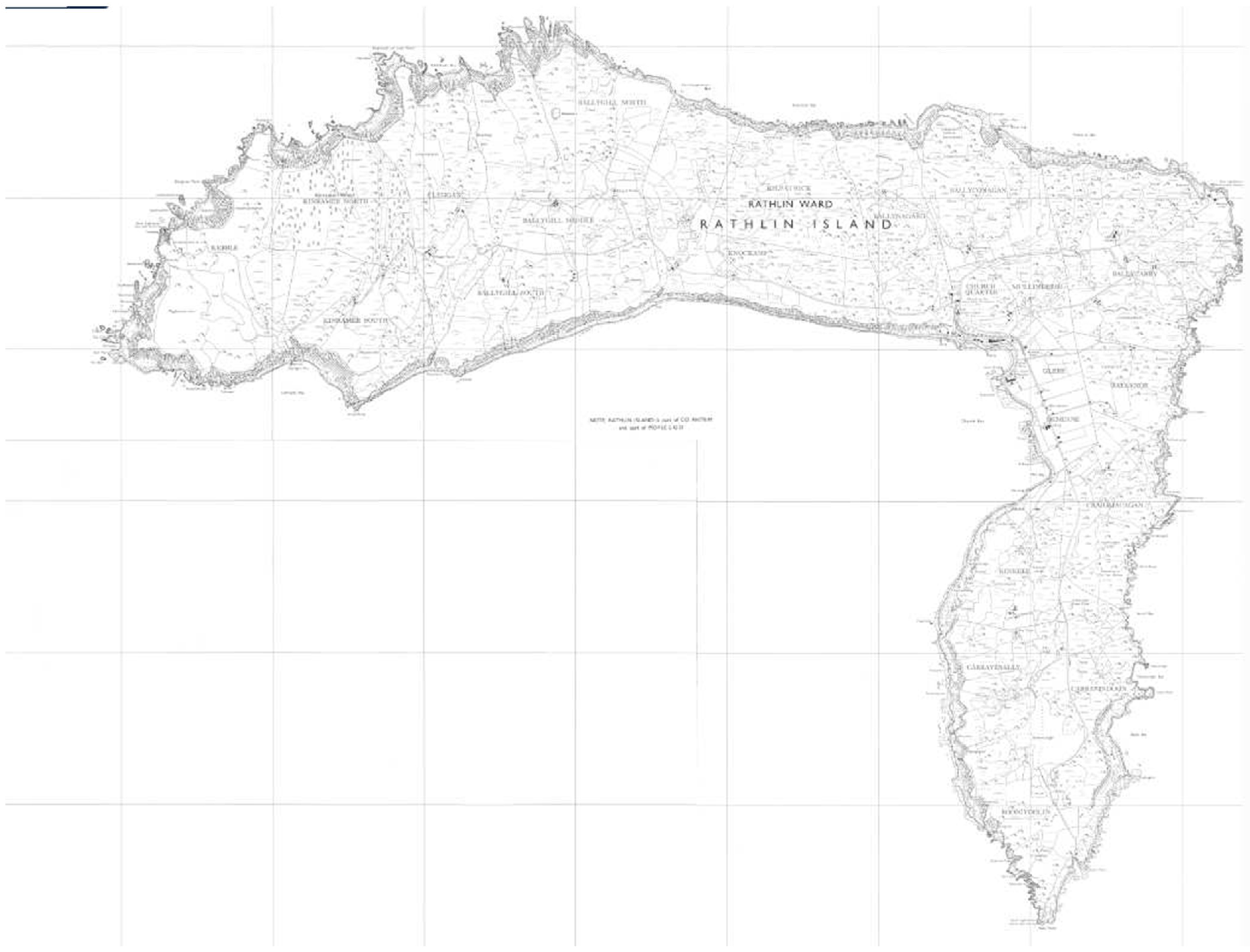
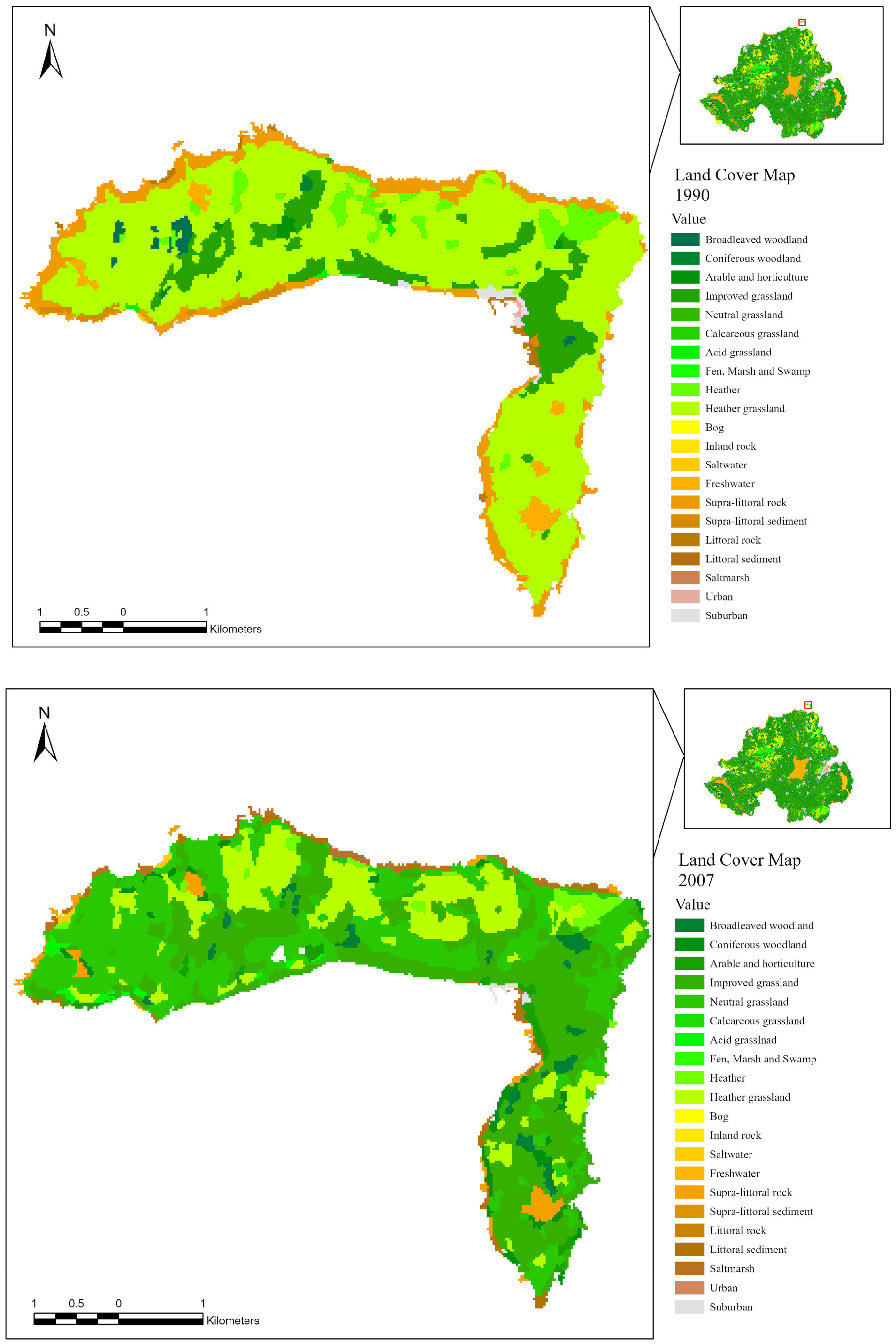
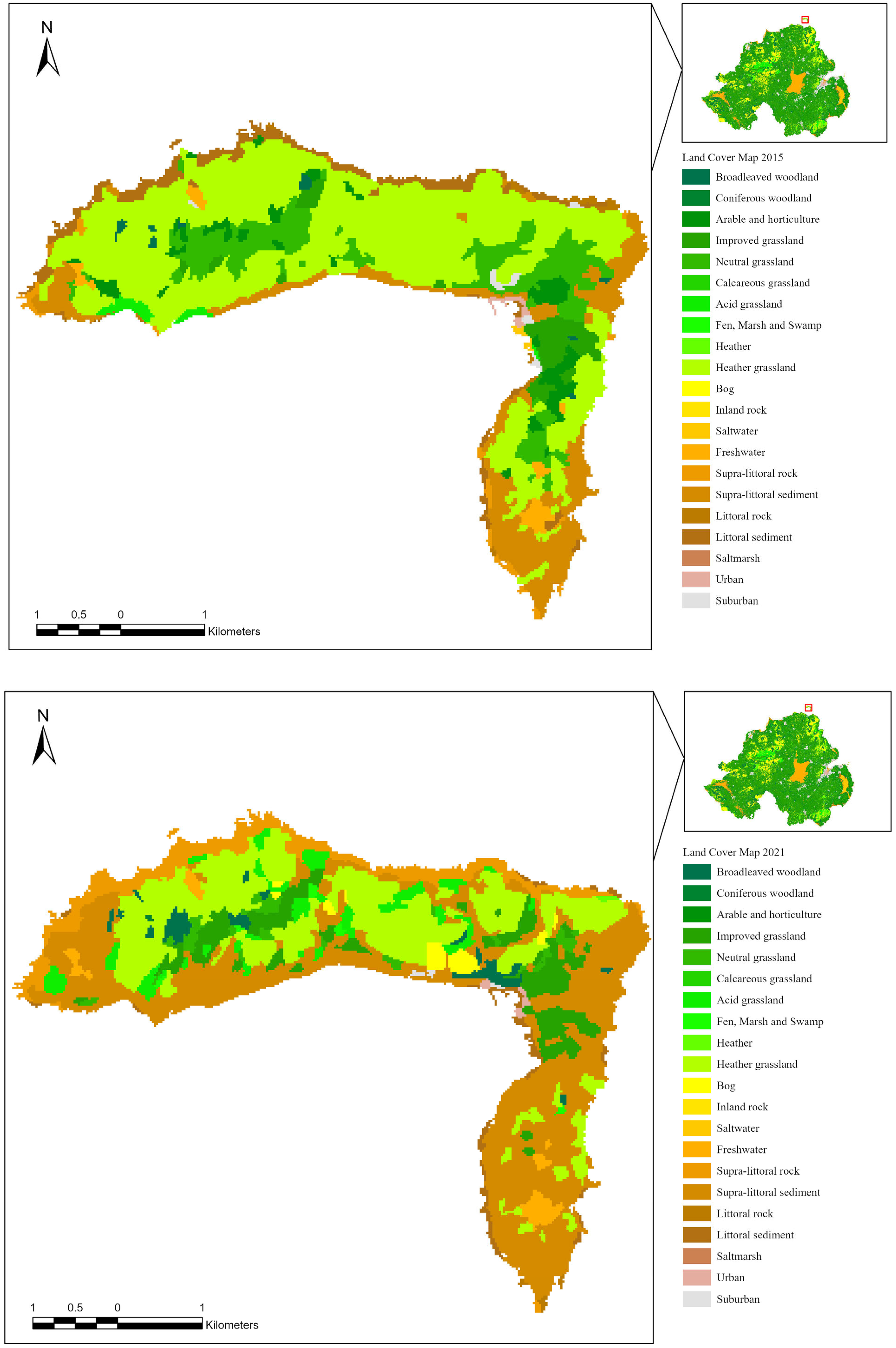


Disclaimer/Publisher’s Note: The statements, opinions and data contained in all publications are solely those of the individual author(s) and contributor(s) and not of MDPI and/or the editor(s). MDPI and/or the editor(s) disclaim responsibility for any injury to people or property resulting from any ideas, methods, instructions or products referred to in the content. |
© 2025 by the authors. Licensee MDPI, Basel, Switzerland. This article is an open access article distributed under the terms and conditions of the Creative Commons Attribution (CC BY) license (https://creativecommons.org/licenses/by/4.0/).
Share and Cite
Zheng, Y.; McConnell, R.J.; Zhou, Z.; Jefferies, T.; Keeffe, G.; Cullen, S.; Campbell, E. Visual Storytelling of Landscape Change on Rathlin Island, UK. Land 2025, 14, 1304. https://doi.org/10.3390/land14061304
Zheng Y, McConnell RJ, Zhou Z, Jefferies T, Keeffe G, Cullen S, Campbell E. Visual Storytelling of Landscape Change on Rathlin Island, UK. Land. 2025; 14(6):1304. https://doi.org/10.3390/land14061304
Chicago/Turabian StyleZheng, Ying, Rebecca Jane McConnell, Zehan Zhou, Tom Jefferies, Greg Keeffe, Sean Cullen, and Emma Campbell. 2025. "Visual Storytelling of Landscape Change on Rathlin Island, UK" Land 14, no. 6: 1304. https://doi.org/10.3390/land14061304
APA StyleZheng, Y., McConnell, R. J., Zhou, Z., Jefferies, T., Keeffe, G., Cullen, S., & Campbell, E. (2025). Visual Storytelling of Landscape Change on Rathlin Island, UK. Land, 14(6), 1304. https://doi.org/10.3390/land14061304






